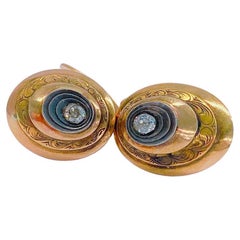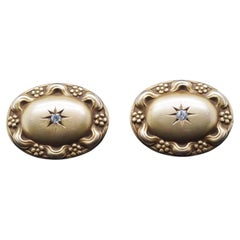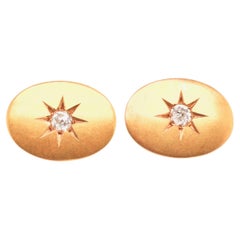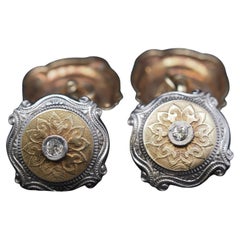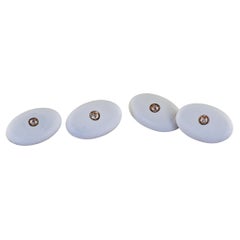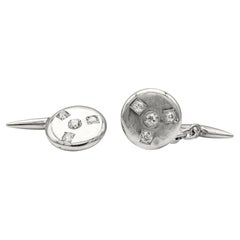Old Diamond Cufflinks
Vintage 1920s Art Deco Cufflinks
Diamond, Gold, Yellow Gold
Antique Early 1900s Cufflinks
Diamond, 14k Gold
Vintage 1910s Edwardian Cufflinks
Diamond, Platinum
Antique Early 1900s Art Nouveau Cufflinks
Diamond, Gold, 14k Gold, Yellow Gold
Antique Early 1900s Edwardian Cufflinks
Diamond, 14k Gold, Yellow Gold
Antique Early 1900s Edwardian Cufflinks
Diamond, Gold, 14k Gold, Yellow Gold, Platinum
Vintage 1920s Art Deco Cufflinks
Diamond, Gold, 14k Gold, Yellow Gold, Enamel
Vintage 1960s Unknown Cufflinks
Diamond, 18k Gold, White Gold
Early 20th Century English Art Deco Cufflinks
Diamond, Sapphire, 14k Gold, Yellow Gold, Platinum
Antique 1890s Unknown Victorian Cufflinks
Diamond, 14k Gold, Yellow Gold
Vintage 1910s Unknown Art Deco Cufflinks
Diamond, Yellow Gold, Platinum
Early 20th Century Art Deco Cufflinks
Diamond, Onyx, Opal, Black Opal, 18k Gold, White Gold
2010s American Modern Cufflinks
Diamond
Antique 1870s European Victorian Cufflinks
Diamond, Ruby, 18k Gold
Vintage 1980s British Victorian Cufflinks
Diamond, 18k Gold, Yellow Gold, Enamel
Vintage 1920s Art Deco Cufflinks
Diamond, 18k Gold, Platinum, Gold, Enamel
Vintage 1930s Unknown Cufflinks
Diamond, Yellow Gold
Vintage 1930s French Cufflinks
Diamond, 14k Gold, Rose Gold, Platinum
Vintage 1920s American Art Deco Cufflinks
Diamond, Onyx
Antique 19th Century Art Nouveau Cufflinks
Diamond, Gold, Enamel
Antique 1890s French Art Nouveau Cufflinks
Diamond, Gold, 18k Gold
Antique Early 1900s Edwardian Cufflinks
Diamond, Gold, 14k Gold, Yellow Gold, Platinum
Vintage 1920s Unknown Art Deco Cufflinks
Diamond, Onyx, White Gold
Vintage 1910s European Edwardian Cufflinks
Diamond, 18k Gold, Platinum
Vintage 1910s British Art Nouveau Cufflinks
Diamond, 18k Gold, Yellow Gold
Antique 1890s Unknown Cufflinks
Diamond, Yellow Gold
Early 20th Century Cufflinks
Diamond, Sapphire, Gold, 18k Gold, Yellow Gold
Antique Mid-19th Century Cufflinks
Diamond, Gold, 14k Gold, Yellow Gold, Silver, Enamel
Vintage 1930s Unknown Cufflinks
Crystal, Diamond, 14k Gold, Yellow Gold, Platinum
Vintage 1920s Unknown Art Deco Cufflinks
Diamond, Sapphire, 18k Gold, Platinum
Vintage 1920s American Art Deco Cufflinks
White Diamond, Blue Sapphire, Platinum
Early 20th Century Art Deco Cufflinks
Diamond, Sapphire, Platinum
Early 20th Century French Belle Époque Cufflinks
Diamond, Gold, Platinum
Antique Late 19th Century Austrian Belle Époque Cufflinks
Coral, Diamond, 18k Gold, Yellow Gold
Antique 19th Century Art Nouveau Cufflinks
Diamond, Gold, Yellow Gold
Antique Early 1900s Victorian Cufflinks
Diamond, Gold, 14k Gold, Yellow Gold
Antique 1890s Victorian Cufflinks
Diamond, 18k Gold
Early 20th Century French Edwardian Cufflinks
Diamond, Gold, Platinum
20th Century Cufflinks
Diamond, Gold, 18k Gold, White Gold, Yellow Gold, Enamel
Antique 1890s Late Victorian Cufflinks
Diamond, Ruby, Sapphire, Gold, 18k Gold
Early 20th Century Victorian Cufflinks
Diamond, 10k Gold, Rose Gold
Vintage 1920s Art Deco Cufflinks
Diamond, 14k Gold, Yellow Gold
Early 20th Century French Art Deco Cufflinks
Diamond, Onyx, 18k Gold, Platinum
Vintage 1920s Art Deco Cufflinks
Diamond, 14k Gold, Yellow Gold, Platinum
Early 20th Century British Edwardian Cufflinks
Carnelian, Diamond, 18k Gold, Yellow Gold, Platinum
Early 20th Century North American Victorian Cufflinks
Diamond, Sapphire, Gold, 14k Gold
Early 20th Century North American Victorian Cufflinks
Diamond, Sapphire, Gold, 14k Gold
Antique Early 1900s French Art Deco Cufflinks
Diamond, Ruby, Sapphire, Blue Sapphire, Gold, 18k Gold, Yellow Gold
20th Century Cufflinks
Diamond, Ruby, Sapphire, 14k Gold, Rose Gold, Yellow Gold, Gold
Early 20th Century French Art Deco Cufflinks
Diamond, Gold, Yellow Gold, 18k Gold, Platinum, Enamel
Vintage 1920s Cufflinks
Diamond, 18k Gold, White Gold, Yellow Gold, Gold
Antique Early 1900s Unknown Cufflinks
Diamond, White Diamond, 18k Gold, Yellow Gold
Antique Early 1900s French Art Nouveau Cufflinks
Diamond, White Diamond, Gold, 18k Gold, Platinum
Antique Early 1900s Cufflinks
Diamond, 18k Gold, Gold, Yellow Gold
Vintage 1930s Unknown Art Deco Cufflinks
Diamond, Onyx, Gold
Vintage 1920s Art Deco Cufflinks
Diamond, Onyx, Gold, 18k Gold, Platinum
Antique 1880s British Late Victorian Cufflinks
Diamond, Gold, 18k Gold, Silver, Enamel
Vintage 1920s British Art Deco Cufflinks
Diamond, Blue Sapphire, Gold, Yellow Gold, Platinum
Antique Early 1900s American Art Nouveau Cufflinks
Diamond, 14k Gold
Mid-20th Century Art Deco Cufflinks
Diamond, Onyx, 18k Gold, White Gold
- 1
Old Diamond Cufflinks For Sale on 1stDibs
How Much are Old Diamond Cufflinks?
Why Gold Shines in Jewelry Craftsmanship
Gold is the feel-good metal, the serotonin of jewelry. Wear vintage and antique gold necklaces, watches, gold bracelets or gold rings and you feel happy, you feel dressed, you feel, well, yourself.
Gold, especially yellow gold, with its rich patina and ancient pedigree going back thousands of years, is the steady standby, the well-mannered metal of choice. Any discussion of this lustrous metal comes down to a basic truth: Gold is elementary, my dear. Gold jewelry that couples the mystique of the metal with superb design and craftsmanship achieves the status of an enduring classic. Many luxury houses have given us some of our most treasured and lasting examples of gold jewelry over the years.
Since its founding, in 1837, Tiffany & Co. has built its reputation on its company jewelry as well as its coterie of boutique designers, which has included Jean Schlumberger, Donald Claflin, Angela Cummings and Elsa Peretti. There are numerous gold Tiffany classics worth citing. Some are accented with gemstones, but all stand out for their design and the workmanship displayed.
For the woman who prefers a minimalist look, the Tiffany & Co. twist bangle (thin, slightly ovoid) is stylishly simple. For Cummings devotees, signature pieces feature hard stone inlay, such as her pairs of gold ear clips inlaid with black jade (a play on the classic Chanel black and tan), or bangles whose design recalls ocean waves, with undulating lines of lapis lazuli and mother-of-pearl. And just about any design by the great Jean Schlumberger is by definition a classic.
Even had he eschewed stones and diamonds, Southern-born David Webb would be hailed for the vast arsenal of heavy gold jewelry he designed. Gold, usually hammered or textured in some manner, defines great David Webb jewelry. The self-taught jeweler made very au courant pieces while drawing inspiration from ancient and out-of-the-way sources — East meets West in the commanding gold necklaces made by Webb in the early 1970s. The same could be said for his endlessly varied gold cuffs.
In Europe, many houses have given us gold jewelry that sets the highest standard for excellence, pieces that were highly sought after when they were made and continue to be so.
Numerous designs from Cartier are homages to gold. There are the classic Trinity rings, necklaces and bracelets — trifectas of yellow, white and rose gold. As a testament to the power of love, consider the endurance of the Cartier Love bracelet.
Aldo Cipullo, Cartier’s top in-house designer from the late 1960s into the early ’70s, made history in 1969 with the Love bracelet. Cipullo frequently said that the Love bracelet was born of a sleepless night contemplating a love affair gone wrong and his realization that “the only remnants he possessed of the romance were memories.” He distilled the urge to keep a loved one close into a slim 18-karat gold bangle.
BVLGARI and its coin jewelry, gemme nummarie, hit the jackpot when the line launched in the 1960s. The line has been perennially popular. BVLGARI coin jewelry features ancient Greek and Roman coins embedded in striking gold mounts, usually hung on thick link necklaces of varying lengths. In the 1970s, BVLGARI introduced the Tubogas line, most often made in yellow gold. The Tubogas watches are classics, and then there is the Serpenti, the house's outstanding snake-themed watches and bracelets.
A collection called Monete that incorporated the gold coins is one of several iconic BVLGARI lines that debuted in the 1970s and ’80s, catering to a new generation of empowered women. Just as designers like Halston and Yves Saint Laurent were popularizing fuss-free ready-to-wear fashion for women on the go, BVLGARI offered jewels to be lived in.
Since Van Cleef & Arpels opened its Place Vendôme doors in 1906, collection after collection of jewelry classics have enchanted the public. As predominantly expressed in a honeycomb of gold, there is the Ludo watch and accessories, circa the 1920s, and the golden Zip necklace, 1951, whose ingenious transformation of the traditional zipper was originally proposed by the Duchess of Windsor. Van Cleef's Alhambra, with its Moroccan motif, was introduced in 1968 and from the start its popularity pivoted on royalty and celebrity status. It remains one of VCA’s most popular and collected styles.
Mention must be made of Buccellati, whose name is synonymous with gold so finely spun that it suggests tapestry. The house’s many gold bracelets, typically embellished with a few or many diamonds, signified taste and distinction and are always in favor on the secondary market. Other important mid-20th-century houses known for their gold-themed jewelry include Hermès and Ilias Lalaounis.
Find a stunning collection of vintage and antique gold jewelry on 1stDibs.
The Legacy of Diamond in Jewelry Design
Antique diamond rings, diamond tiaras and dazzling vintage diamond earrings are on the wish lists of every lover of fine jewelry. And diamonds and diamond jewelry are primarily associated with storybook engagements and red-carpet grand entrances — indeed, this ultra-cherished gemstone has a dramatic history on its hands.
From “A Diamond Is Forever” to “Diamonds Are a Girl’s Best Friend,” pop culture has ingrained in our minds that diamonds are the most desired, the most lasting and the most valuable gemstone. But what makes the diamond so special? Each stone — whether it’s rubies, sapphires or another stone — is unique and important in its own right. April babies might claim diamonds for themselves, but just about everyone wants this kind of sparkle in their lives!
There are several factors that set diamonds apart from other stones, and these points are important to our gem education.
Diamonds are minerals. They are made up of almost entirely of carbon (carbon comprises 99.95 percent; the remainder consists of various trace elements). Diamonds are the hardest gemstones, ranking number 10 on the Mohs Hardness Scale. Even its name, diamond, is rooted in the Greek adamas, or unconquerable. The only object that can scratch a diamond is another diamond. Diamonds are formed deep within the earth at very high temperatures (1,652–2,372 degrees Fahrenheit at depths between 90 and 120 miles beneath the earth’s surface) and are carried up by volcanic activity. Diamonds are quite rare, according to the Gemological Institute of America, and only 30 percent of all the diamonds mined in the world are gem quality.
In the 1950s, the Gemological Institute of America developed the 4Cs grading system to classify diamonds: clarity, color, cut and carat weight. Not all diamonds are created equal (there are diamonds, and then there are diamonds). The value of the diamond depends on the clarity (flawless diamonds are very rare but a diamond's value decreases if there are many blemishes or inclusions), color (the less color the higher the grade), cut (how the diamond’s facets catch the light, certain cuts of diamonds show off the stone better than others) and carat weight (the bigger, the better).
When you start shopping for a diamond engagement ring, always prioritize the cut, which plays the largest role in the diamond's beauty (taking the time to clean your diamond ring at least every six months or so plays a role in maintaining said beauty). And on 1stDibs, a range of buying guides can be found for those in the market for antique engagement rings, vintage engagement rings or Art Deco engagement rings.
Shop antique and vintage diamond rings, diamond necklaces and other extraordinary diamond jewelry on 1stDibs.
Finding the Right Cufflinks for You
Cufflinks rose to popularity during the 1800s as fashionable men sought a refined and elegant solution for keeping their shirtsleeves together. Prior to this accessory, which initially materialized as a simple chain fastened to a button, men were lacing the ends of their sleeves with ribbon or string. Today, there are all manner of antique and vintage cufflinks that add flair and functionality to relaxed casual wear as much as they do for classy formal attire.
It wasn’t long before diamonds, emeralds and other precious gemstones began to appear on cufflinks, a means of adding ornament to clean and starched formal wear. When clothing manufacturers began to produce shirt cuffs and collars with more durable materials during the 19th century, a class of newer, stronger cufflinks gained credibility as being both essential and stylish. In the decades following this era’s design evolution, an entire industry bloomed around the craft of these subtle statement pieces.
Luxury brands more often associated with engagement rings and bracelets, such as Cartier and Tiffany & Co., have added cufflinks to their lines over the years, and jewelry designers, working in numerous styles, have explored the use of different materials and integrated a variety of ornamentation. Understated cufflinks of gold and platinum are guaranteed to cleanly complement any ensemble, while more niche designs allow the jewels to truly shine.
Cufflinks are practical pieces of jewelry that can also be very expressive. Consider the event for which you’re donning cufflinks and accessorize accordingly, but know that a distinctive pair of cufflinks, such as the colorful confections offered by Trianon, can pop against your dressy evening wear. Whether they’re geometric wonders of the Art Deco era, reliably relevant skull jewels or glittering accessories designed by Van Cleef & Arpels, adorned with the maison’s celebrated four-leaf clover or prominent animal motifs, you can delicately break from what can be a stuffy business meeting by introducing personality and pizzazz with a duo of nifty cufflinks.
A carefully chosen set of cufflinks can bring a stylish outfit together — literally. Find a large, luxurious collection of contemporary cufflinks as well as irresistible vintage pieces on 1stDibs today.
- How do I identify old cufflinks?1 Answer1stDibs ExpertApril 5, 2022Having an expert identify vintage cufflinks is the best way to ensure an accurate evaluation. Cufflinks first made their appearance in the 17th century, and became popular through the 19th century. Shop a range of vintage and contemporary cufflinks on 1stDibs.
- 1stDibs ExpertMay 5, 2023How old an old European-cut diamond is varies. The old European cut is a precursor to the modern round brilliant cut. The stone appears circular when looked at from the top (because of its low table or largest facet) and has a high crown (the part above the middle of the stone) with larger facets. The tip of the stone, or the culet, is flat instead of pointed. This style was used predominantly in the 19th century, hence the name. It is best to consult a certified appraiser for assistance with dating and identifying antique jewelry. On 1stDibs, find a variety of European-cut diamond jewelry.
- What is an old European diamond?1 Answer1stDibs ExpertApril 5, 2022An old European diamond is one that features an Old European gemstone cut. This type of cut became popular during the Art Deco period and has a round shape with 58 central facets. You'll find a variety of European cut diamond gemstone jewelry on 1stDibs.
- How old are mine cut diamonds?1 Answer1stDibs ExpertApril 5, 2022Mine cut diamonds are up to 300 years ago. Mine cut diamonds were popular around the 18th century during Victorian times and are still in high demand today. You’ll find a wide selection of mine cut diamond jewelry on 1stDibs.
- 1stDibs ExpertFebruary 22, 2021Although old European cut diamonds are often priced lower than modern cuts, due to scarcity, they can sometimes be more valuable than modern cut diamonds.
- 1stDibs ExpertApril 5, 2022Jewelry makers stopped using the old European cut for diamond and other gemstone jewelry around 1930. The style was common during the Art Deco period, but the brilliant cut became popular in the years that followed. On 1stDibs, shop a selection of Old European cut diamond gemstone jewelry.
- 1stDibs ExpertFebruary 22, 2021Because the old mine cut is no longer used on diamonds, diamonds with this cut are rare and so you can often get quite a lot of money for them. Nevertheless, it is still dependent on the quality of the individual diamonds and on the color, clarity, cut and carat number.
- 1stDibs ExpertAugust 24, 2021Yes, old European cut diamonds can be worth more than many other cut diamonds as they are not produced anymore. This cut was developed and popularized between the years 1890 and 1930 and is likely to be found in an antique ring belonging to this period and featuring a round-cut diamond.
- 1stDibs ExpertFebruary 22, 2021Old mine cut diamonds are usually worth less than old european cut diamonds. Because they are generally 10-15% less expensive, they are often larger than other cut diamonds for engagement rings.
 Roman Malakov DiamondsMarch 22, 2021Like any other diamond, an old mine cut diamond's worth depends on a variety of factors. These factors include the 4C's (color, clarity, cut, carat), the overall beauty and "make" of the stone, the demand, supply, etc. On average however, old mine cuts are typically priced slightly lower (around 5-10%) than modern cut diamonds.
Roman Malakov DiamondsMarch 22, 2021Like any other diamond, an old mine cut diamond's worth depends on a variety of factors. These factors include the 4C's (color, clarity, cut, carat), the overall beauty and "make" of the stone, the demand, supply, etc. On average however, old mine cuts are typically priced slightly lower (around 5-10%) than modern cut diamonds.

